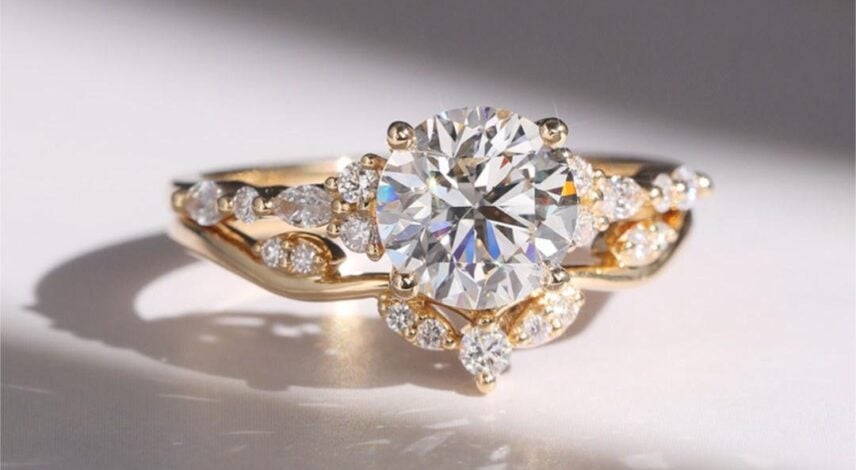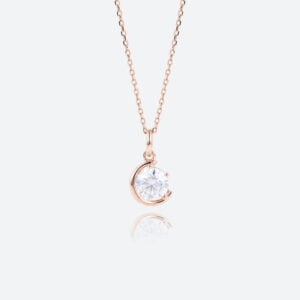Understanding Lab-Grown Diamond Clarity: What Makes Each Grade Different?
0 comments
SHOP BY STYLE ✧
SHOP BY SHAPE ✧
![]()
![]()
![]()
![]()
![]()
METAL COLOR ✧
WEDDING BANDS
SHOP BY STYLE ✧
![]()
![]()
![]()
SHOP BY STONE ✧
SHOP BY METAL ✧
JEWELRY FOR THE BIG DAY
NECKLACES ✧
EARRINGS ✧
BRACELETS ✧
Engagement ✧
SHOP BY SHAPE ✧
![]()
![]()
![]()
![]()
![]()
![]()
SHOP BY COLOR ✧
SHOP BY CATEGORY✧

SHOP BY CATEGORY✧
SHOP BY OCCASION✧
SHOP BY PRICE✧

Birthstone Jewelry

In recent years, lab-grown diamonds have transformed the jewelry industry. Praised for their ethical origins, eco-friendly production, and exceptional value, these man-made gems are virtually identical to natural diamonds in every way — chemically, optically, and physically. Yet, just like mined diamonds, not all lab-grown diamonds are created equal.
When shopping for a diamond—whether for an engagement ring, pendant, or pair of earrings—buyers often focus on the Four Cs: cut, color, carat, and clarity. Among these, clarity is one of the most misunderstood. Many assume higher clarity always means a more beautiful diamond, but that’s not necessarily true.
In this article, we’ll explore what diamond clarity really means, how it’s graded, how lab-grown diamonds differ from natural ones, and most importantly, how to choose the right clarity grade for your preferences and budget. By the end, you’ll know exactly what makes a VVS1 diamond different from a VS2, and why certain clarity levels offer the best balance of beauty and value.
Diamond clarity refers to the absence—or presence—of internal and external imperfections, known respectively as inclusions and blemishes. These tiny characteristics form during the diamond’s creation process and can affect how light passes through the stone, influencing its brilliance and transparency.
Even though inclusions are natural, they are often invisible to the naked eye. Gemologists evaluate clarity under 10x magnification, assigning grades that indicate how easily inclusions can be seen and whether they impact the stone’s beauty or structure.
| Clarity Grade | Meaning | Description |
|---|---|---|
| FL (Flawless) | No inclusions or blemishes | Extremely rare and pristine |
| IF (Internally Flawless) | No internal inclusions; only minor surface blemishes | Visually perfect to the naked eye |
| VVS1–VVS2 (Very Very Slightly Included) | Minute inclusions, difficult to detect even under magnification | Nearly flawless in appearance |
| VS1–VS2 (Very Slightly Included) | Small inclusions visible only under magnification | Excellent balance of clarity and value |
| SI1–SI2 (Slightly Included) | Noticeable inclusions visible under 10x magnification, sometimes faintly visible to the eye | Great value option |
| I1–I3 (Included) | Inclusions easily visible to the naked eye | Often affects brilliance and durability |
For lab-created diamonds, the same grading principles apply. Certified gemological laboratories use identical clarity criteria as for mined diamonds, ensuring fair and standardized comparisons.
When it comes to clarity, lab-grown diamonds often have a natural advantage over mined diamonds. The difference lies in how they’re formed.
Natural diamonds form deep underground under extreme pressure and heat over billions of years. During this long and uncontrolled process, foreign minerals or tiny fractures can become trapped inside the crystal structure, resulting in inclusions. These imperfections are completely natural — they’re the “fingerprints” of Earth’s creation process.
Lab-created diamonds, on the other hand, are produced in controlled environments using HPHT (High Pressure High Temperature) or CVD (Chemical Vapor Deposition) methods. Because the conditions are carefully monitored, the resulting diamonds typically have fewer inclusions and a more consistent structure.
That said, not all lab-grown diamonds are flawless. Even in a laboratory, minute inclusions can form due to trace metallic particles (especially in HPHT diamonds) or growth patterns (in CVD diamonds). However, these are usually microscopic and have little to no visual impact.

👉 Key takeaway:
A VS2 lab-grown diamond often looks just as clean as a VVS1 natural diamond, but costs significantly less. This is one of the main reasons why more buyers are turning to lab-grown diamonds—they offer superior clarity and size for the same budget without compromising brilliance or beauty.
Let’s take a closer look at the diamond clarity scale and what each grade means for your jewelry. Even a small difference in clarity can influence both price and appearance, so understanding these categories helps you make a smarter choice.
Definition:
No inclusions (FL) or only minor surface blemishes (IF) visible under 10x magnification.
Visual Impact:
Perfectly transparent, with nothing obstructing the passage of light.
Rarity & Price:
Extremely rare—less than 1% of diamonds fall into this category. Typically priced at a significant premium.
Best for:
Collectors or customers who prioritize perfection and exclusivity.
Note:
The visual difference between an IF diamond and a VVS1 is almost impossible to detect without professional tools.
Definition:
Minute inclusions that are extremely difficult to detect even under magnification.
Visual Impact:
Visually identical to flawless diamonds to the naked eye.
Rarity & Price:
Highly sought-after due to their near-perfect appearance but slightly more affordable than FL/IF.
Best for:
Buyers seeking exceptional purity and brilliance without paying the “flawless premium.”
Example:
A VVS1 lab-grown diamond often delivers unmatched sparkle and clarity for engagement rings.
Definition:
Small inclusions visible under 10x magnification but rarely noticeable without it.
Visual Impact:
Excellent clarity; inclusions usually hidden by the diamond’s facets.
Value Factor:
The sweet spot for most buyers—beautiful, bright, and far more budget-friendly than higher grades.
Best for:
Engagement rings, solitaires, and other jewelry where brilliance matters most.
Pro Tip:
A VS2 lab-grown diamond often appears flawless to the naked eye, offering one of the best clarity-to-value ratios available.
Definition:
Noticeable inclusions under magnification, and in some cases faintly visible to the naked eye.
Visual Impact:
Minimal effect on sparkle if inclusions are small or located near the edges.
Price Advantage:
Outstanding value for larger carat sizes—perfect for buyers who want size over perfection.
Best for:
Practical buyers looking for balance between carat weight and clarity.
Note:
Choose SI1 lab-grown diamonds from reputable sources that ensure inclusions don’t affect brilliance or durability.
Definition:
Obvious inclusions that may affect brilliance, durability, or transparency.
Visual Impact:
Inclusions easily visible to the eye, sometimes appearing as dark spots or cloudy areas.
Recommendation:
Usually not ideal for fine jewelry settings, but may be acceptable for accent stones or fashion pieces where sparkle is less critical.
When it comes to diamond clarity, many shoppers assume that higher grades automatically mean a more beautiful diamond. In reality, the difference between grades like VS1, VS2, and even SI1 is often imperceptible to the naked eye — but the price difference can be substantial.
The diamond clarity scale is exponential, not linear. That means each jump in clarity—say, from VS2 to VVS1—represents a sharp increase in rarity, and therefore price, even though the visual improvement is minimal. For example:
| Clarity Grade | Typical Appearance | Relative Price |
|---|---|---|
| FL/IF | Absolutely clean, perfect brilliance | $$$$$ |
| VVS1–VVS2 | Visually flawless to the naked eye | $$$$ |
| VS1–VS2 | Clean to the naked eye, inclusions only under magnification | $$$ |
| SI1–SI2 | Tiny inclusions, rarely visible unless inspected closely | $$ |
| I1 and below | Visible inclusions, reduced brilliance | $ |
💡 Practical Example:
A 1-carat VVS1 lab-grown diamond might cost 25–40% more than a VS2 diamond of the same size and color, yet both appear identical once set in a ring. That’s why jewelers often recommend focusing on eye-clean clarity—diamonds that look flawless even if they technically aren’t under magnification.
For most buyers, clarity is about perception, not perfection. Unless you’re examining your diamond under a loupe every day, a well-cut VS2 or even SI1 lab-grown diamond will sparkle just as brilliantly as a flawless one.
Selecting the right clarity grade for your lab-grown diamond depends on three key factors:
Let’s explore each of these in more depth.
The larger the diamond, the easier it becomes to see inclusions. A 2-carat diamond with SI1 clarity might show inclusions that a 1-carat diamond at the same grade would hide completely.
Certain ring designs naturally conceal imperfections better than others.
If you’re opting for a minimalist solitaire, investing in a VS1 or VVS2 may be worthwhile.
Many jewelry experts agree: cut quality has the greatest impact on brilliance, far more than clarity.
A well-cut VS2 diamond will appear more radiant than a poorly cut VVS1.
So if you’re allocating budget, prioritize:
This ensures your diamond achieves maximum sparkle without overspending on invisible upgrades.
Ultimately, diamond shopping is personal. Here’s a quick guide to help you decide:
| Buyer Type | Recommended Clarity | Reason |
|---|---|---|
| Perfectionist / Collector | FL – VVS1 | Virtually flawless, investment-grade quality |
| Style & Sparkle Lover | VS1 – VS2 | Eye-clean, bright, and best overall value |
| Budget-Conscious Buyer | SI1 – SI2 | Affordable and still visually appealing when well-cut |
| Ethical & Eco-Focused Shopper | VS1 – SI1 (Lab Grown) | Sustainable, high-clarity diamonds at a fraction of mined prices |
As the jewelry industry evolves, lab-grown diamonds have emerged as a brilliant alternative for modern consumers seeking both luxury and conscience. Beyond their ethical and environmental benefits, these diamonds often offer superior clarity, beauty, and value—making them the preferred choice for a new generation of buyers.
Lab-grown diamonds are formed under controlled conditions using advanced CVD and HPHT technologies. Because these processes minimize impurities and inclusions, most lab diamonds naturally achieve VS1 to VVS2 clarity—a range that ensures dazzling brilliance without imperfections visible to the naked eye.
Unlike mined diamonds, which require extensive land excavation and may involve controversial labor practices, lab-created diamonds are produced sustainably and ethically. Every LisaJewelryUS diamond is conflict-free, ensuring that your jewelry not only shines beautifully but also reflects integrity and respect for the planet.
Lab-grown diamonds are chemically and optically identical to mined ones—but they cost 40–60% less. This means you can choose a higher clarity or larger carat weight while staying within your budget. You’re investing in brilliance and craftsmanship, not mining logistics.
Each LisaJewelryUS lab-grown diamond is independently graded by renowned institutes like IGI or GIA, verifying its clarity, color, cut, and carat weight. This certification guarantees that what you purchase is 100% authentic and of the highest gemological standard.
Choosing a lab-grown diamond means choosing innovation, purity, and responsibility. These gems symbolize the modern love story—brilliant, conscious, and enduring—just like the relationships they celebrate.
When choosing a diamond, clarity plays a significant role in defining its beauty—but perfection isn’t the only path to brilliance. A well-cut VS2 or SI1 lab-grown diamond can shine just as beautifully as a flawless one, especially when thoughtfully chosen and ethically sourced.
Lab-grown diamonds empower buyers to embrace elegance with conscience—offering the same sparkle, structure, and sentiment as mined stones, without the environmental cost.
At LisaJewelryUS, we believe your diamond should reflect not only your love story but also your values.
Choose clarity that speaks to your heart—and let your brilliance shine sustainably.
✨ Discover our collection today and find the perfect balance of beauty, integrity, and timeless radiance.